Themed collection Highlighting materials research in the UK for optical, magnetic and electronic devices

Arylsilanes and siloxanes as optoelectronic materials for organic light-emitting diodes (OLEDs)
Arylsilanes and siloxanes have been extensively studied as components of OLEDs. In this review, we summarize the recent advances in the utilization of arylsilanes and siloxanes as fluorophore emitters, hosts for phosphor emitters, hole and exciton blocking materials, and as electron and hole transporting materials.
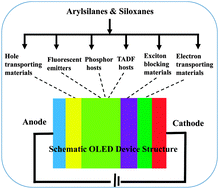
J. Mater. Chem. C, 2015,3, 9496-9508
https://doi.org/10.1039/C5TC01638J
Oxygen diffusion dynamics in organic semiconductor films
Transient absorption spectroscopy is commonly used to probe the yield and kinetics of excited states of materials.

J. Mater. Chem. C, 2015,3, 10079-10084
https://doi.org/10.1039/C5TC02822A
Thia- and selena-diazole containing polymers for near-infrared light-emitting diodes
Incorporation of a class of selenium-based near-infrared emitters (benzotriazoloselenadiazoles) into PLEDs and direct comparison between thia- and selena-diazole donor–acceptor–donor units.

J. Mater. Chem. C, 2015,3, 2792-2797
https://doi.org/10.1039/C5TC00118H
New solid-state Eu(III)-containing metallo-supramolecular polymers: morphology control and optical wave-guiding properties
Preparation, photophysical studies, and optical wave-guiding properties of morphology controllable Eu(III) containing coordination polymers in the solid state.

J. Mater. Chem. C, 2015,3, 8992-9002
https://doi.org/10.1039/C5TC01703C
Thin film properties of tetracyanoquinodimethane (TCNQ) with novel templating effects
Film properties and new templating behaviours in strong electron acceptor TCNQ.

J. Mater. Chem. C, 2015,3, 8694-8699
https://doi.org/10.1039/C5TC01778E
The synthesis of CdTe/ZnS core/shell quantum dots using molecular single-source precursors
In this paper, we report the synthesis of CdTe/ZnS quantum dots using molecular single source precursors, and we explore the tuning of the optical properties.

J. Mater. Chem. C, 2015,3, 8425-8433
https://doi.org/10.1039/C5TC01808K
Liquid crystalline textures and polymer morphologies resulting from electropolymerisation in liquid crystal phases
A small fraction of an acrylate liquid crystalline monomer (≤5%) is mixed into nematic and smectic liquid crystalline phases, and polymerised through the application of a voltage (electropolymerisation).

J. Mater. Chem. C, 2015,3, 8018-8023
https://doi.org/10.1039/C5TC01639H
Bead-like structures and self-assembled monolayers from 2,6-dipyrazolylpyridines and their iron(II) complexes
Drop-casting [Fe(bpp)2][BF4]2 (bpp = 2,6-di[pyrazol-1-yl]pyridine) onto HOPG affords chain-of-beads nanostructures. SAMs of bpp derivatives with sulfur-containing tethers are also described.
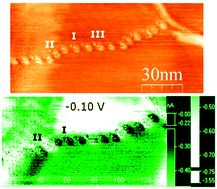
J. Mater. Chem. C, 2015,3, 7890-7896
https://doi.org/10.1039/C5TC01233C
Electronic and optical properties of reduced graphene oxide
Ab initio hybrid DFT theory of graphene dots in graphene oxide predicts optically active energy gaps over visible and UV spectra with strong absorption characteristics and long radiative recombination times.

J. Mater. Chem. C, 2015,3, 7632-7641
https://doi.org/10.1039/C5TC00437C
Elucidating the deprotonation of polyaniline films by X-ray photoelectron spectroscopy
Incubation of PANI films in physiological conditions leads to deprotonation and loss of dopant from the polymer backbone.
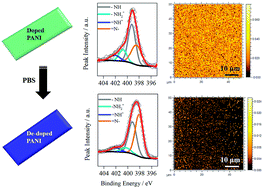
J. Mater. Chem. C, 2015,3, 7180-7186
https://doi.org/10.1039/C5TC01038A
Energy level tuning of blue emitting and electron transporting vinylene bis(vinyl quinolinyl)benzene derivatives: synthesis, characterisation, thin film characterisation and performance in OLEDs
Band gap tuning by attaching aromatic and heterocyclic substituents on the vinylene bis(vinylquinolinyl)benzene moiety results in multifunctional organic semiconductors with high thermal stability and electron mobility.

J. Mater. Chem. C, 2015,3, 6652-6667
https://doi.org/10.1039/C5TC00932D
Structural, optical, magnetic and half-metallic studies of cobalt doped ZnS thin films deposited via chemical bath deposition
Optimized growth of nanocrystalline cobalt doped ZnS thin films on glass substrates was carried out using the CBD method. The structural, morphological, magnetic and optical properties of deposited thin films have been studied.

J. Mater. Chem. C, 2015,3, 6755-6763
https://doi.org/10.1039/C5TC00557D
Photostable phosphorescent polymer nanospheres for high sensitivity detection
A simple method is presented for the preparation of photostable phosphorescent polymer nanospheres.
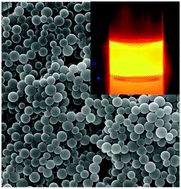
J. Mater. Chem. C, 2015,3, 6565-6572
https://doi.org/10.1039/C5TC00933B
Examining charge transport networks in organic bulk heterojunction photovoltaic diodes using 1/f noise spectroscopy
In this article we present 1/f noise spectroscopy measurements relating to charge transport networks in poly(3-hexylthiophene) (P3HT):phenyl-C61-butyric acid methyl ester (PCBM) space-charge limited diode (SCLD) and organic photovoltaic (OPV) devices.
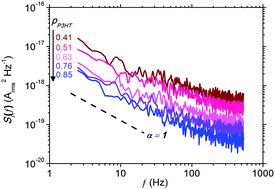
J. Mater. Chem. C, 2015,3, 6077-6085
https://doi.org/10.1039/C5TC00348B
Fluorene copolymer bilayers for emission colour tuning in inverted hybrid light emitting diodes
We report a novel solution deposition process for TFB in inverted OLEDs and demonstrate tuneable emission.
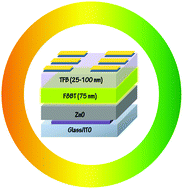
J. Mater. Chem. C, 2015,3, 4945-4953
https://doi.org/10.1039/C5TC00263J
Compatibility of amorphous triarylamine copolymers with solution-processed hole injecting metal oxide bottom contacts
Hole mobility and injection efficiency from ambiently-prepared MoO3, V2O5 and other solution-processable bottom contacts are investigated for polytriarylamine and its silafluorene and fluorene copolymers.

J. Mater. Chem. C, 2015,3, 4530-4536
https://doi.org/10.1039/C4TC02593H
Fluorene co-polymers with high efficiency deep-blue electroluminescence
New deep blue emitting co-polymers are reported. In simple PLED architectures efficiency values as high as ηext,max 3.9% and Lmax 274 cd m−2 with CIE (0.17, 0.07) are obtained.

J. Mater. Chem. C, 2015,3, 2479-2483
https://doi.org/10.1039/C4TC02766C
Incident fluence dependent morphologies, photoluminescence and optical oxygen sensing properties of ZnO nanorods grown by pulsed laser deposition
The photoluminescence-based O2 sensing properties of PLD ZnO nanorods at elevated temperatures depend sensitively on their (incident fluence determined) morphology and defect density.

J. Mater. Chem. C, 2015,3, 2557-2562
https://doi.org/10.1039/C4TC02924K
Self-organisation through size-exclusion in soft materials
Can the interplay between steric and electronic properties induced by end-groups be used to dictate self-organisation in soft materials?

J. Mater. Chem. C, 2015,3, 2380-2388
https://doi.org/10.1039/C4TC02991G
Exploiting the extended π-system of perylene bisimide for label-free single-molecule sensing
We demonstrate the potential of perylene bisimide (PBI) for label-free sensing of organic molecules by investigating the change in electronic properties of five symmetric and asymmetric PBI derivatives, which share a common backbone, but are functionalised with various bay-area substituents.
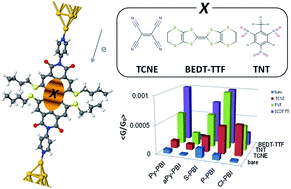
J. Mater. Chem. C, 2015,3, 2101-2106
https://doi.org/10.1039/C4TC02897J
Tailoring the optical properties of poly(3-hexylthiophene) by emulsion processing using polymeric macrosurfactants
Here we demonstrate that the use of macrosurfactants in the production of poly(3-hexylthiophene) (P3HT):water dispersion allows to drastically change the semiconductor's molecular aggregation, leading to pronounced H- or J-like behaviour depending on the macrosurfactant used and the conditions selected to produce the dispersions.

J. Mater. Chem. C, 2015,3, 2065-2071
https://doi.org/10.1039/C4TC02279C
About this collection
Introduced by Professor Peter Skabara, University of Strathclyde
I am delighted to introduce this exciting and hugely impressive web collection highlighting the cream of UK research in materials chemistry which has been published in Journal of Materials Chemistry C in 2015. It is extremely pleasing to see that the collection features well-established scientists, most of who have been publishing in the Journal of Materials Chemistry family of journals throughout their careers. It is equally pleasing and exciting to see the new crop of young talented researchers emerging who will continue to showcase outstanding materials research for the UK community for many years to come.
The work highlighted in this collection covers a wide spectrum of materials chemistry including compound semiconductors and soft matter, processing and devices, new research and a splendid review on the application of silanes and siloxanes in OLED devices.
This collection provides an excellent snapshot of contemporary materials research in the UK. Read the articles and be prepared for some super science.
Best wishes Peter
Professor Peter Skabara
James Young Chair of Chemistry
University of Strathclyde
Deputy Editor-in-Chief, Journal of Materials Chemistry C